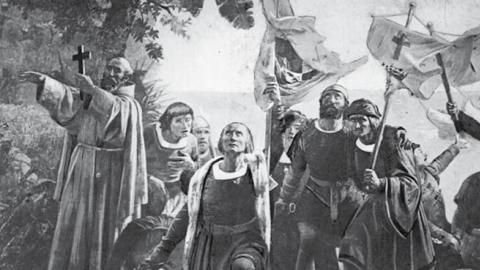Let’s set aside technology and policy for a moment, and talk about America.
In 1891 a mob broke into a New Orleans prison and lynched eleven men who had just been found not guilty on a murder charge. It’s not an unfamiliar tale in the Jim Crow South, except the eleven victims weren’t African-Americans. They were Italian immigrants, part of an American population who had been targets of discrimination since arriving on our shores in large numbers since the 1870’s. Yet a year later Italian-Americans themselves had found a role model and symbol with which to identify themselves, and to assert their determination to succeed in America despite the odds.
That symbol was Christopher Columbus, and the day chosen to commemorate what Italian-Americans have contributed to their adopted country, was October 12—the traditional date for Columbus’s arrival in North America (FDR was the first president to recognize the date as Columbus Day).
Today we are in the midst of a tidal wave of radical attacks on Columbus and Columbus Day. While some cities like Baltimore have ripped down statues to the Genoa-born sailor and explorer, other cities and states have passed legislation to abolish Columbus Day and replace it with Indigenous People’s Day.
In the growing shadow of cancel culture, we need to renew our understanding of the real meaning of Columbus Day for those who raised the first statue to the Italian explorer in Columbus Circle in NYC. No one needs to exonerate Columbus and his Spanish paymasters for the harm they inflicted on American natives more than five hundred years ago. We do need to make sure it stands as a salute to one of the most important and hardest-working immigrant communities in America, whose story is truly the story of America as a nation of immigrants.
For more than a century Christopher Columbus has been a hero to Italian-Americans not because he was an imperialist and racist, but because they saw the Genoa-born Admiral of the Ocean Seas as someone who had used his daring and skill to sail into the unknown across a great ocean, to find a land completely unknown to Europeans; a land full of danger and hardship, but also possibilities for creating a new, better life for those who would come to its shores—just as it was for emigrants fleeing an impoverished and overcrowded Italy.
Unfortunately, what those first immigrants found was a country that didn’t want them. They faced discrimination not just because they were Roman Catholics like the Irish or Poles, who also suffered from attacks by nativists for religious reasons. A series of patrician racist theorists like Madison Grant and Lothrop Stoddard portrayed Italians as racially backward and incapable of becoming “real” Americans. They became prime targets for restrictive immigration legislation, along with Hungarians, Slavs, and Jews from Poland and Russia—restrictions that culminated in the 1924 law imposing immigration quotas for these supposed “undesirables.”
But by then, Italian immigrants already made up nearly 10 percent of the United States’s foreign-born population. Even in the teeth of discrimination and exclusion as noxious illegal aliens (the derogatory term wop being the acronym for “without papers”), they worked tirelessly in our factories, mines, and sweat shops, and crowded into tenement neighborhoods in cities like NYC, San Francisco, Baltimore, and Chicago. They transformed the garment industry and created a host of small businesses, while steadily climbing the social ladder of success until Italian-American politicians like NYC Mayors Fiorello LaGuardia and Rudy Guiliani; businessmen like Amadeo Giannini who created the Bank of America so that Italian-Americans could get the banking services other financial firms denied them; and sports figures like Joe DiMaggio and Rocky Graziano, were fully accepted as part of the American cultural landscape—just as spaghetti, pizza, and cappuccinos became staple parts of the American diet.
In response to the discrimination and opprobrium, Italian-Americans made Christopher Columbus the focal point of their push for inclusion in the larger American society. Just a year after the New Orleans lynching, the Italian-American community in New York City raised $20,000 for a Columbus statue. The nation was celebrating the 400th anniversary of Columbus’s epic voyage in 1892, and the organizers saw an opportunity to raise the profile of Italian-Americans everywhere. The NYC Parks Department wanted to tuck the statue away in Little Italy in Harlem but Italian-American leaders fought for a more prominent place. The statue was raised on what became Columbus Circle, the same position it occupies today.
For more than a hundred years, that statue and others like it, have been symbols of Italian pride and accomplishment in the face of tremendous odds. Far from being a celebration of white colonialism, Columbus Day is about inclusiveness and our nation of immigrants. That’s why we all need to treat Columbus’s statue, and Columbus Day, as national gifts rather than national shames.
Read in Forbes



















